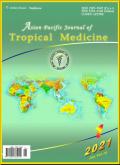Nigella sativa油治疗牙龈炎:一项随机主动对照试验
IF 1.6
4区 医学
Q3 PUBLIC, ENVIRONMENTAL & OCCUPATIONAL HEALTH
引用次数: 0
摘要
目的:比较苦艾油与氯己定治疗牙龈炎的临床抗炎抗菌效果。方法:对慢性全身性牙龈炎患者进行双盲、随机临床试验。患者被随机分配接受Nigella sativa油(n=18)或氯己定(n=19)。在第0天和第15天进行以下评估:使用ELISA、牙菌斑集落形成单位和α-溶血性链球菌菌株测量牙菌斑指数、牙龈指数、牙龈IL-6和IL-18水平。使用参数和非参数检验以及Fisher精确检验对数据进行分析。结果:两种干预措施均能降低牙菌斑指数和牙龈指数得分(P0.05),干预后两组牙菌斑指数、牙龈指数得分和炎症细胞因子水平差异无统计学意义。两种干预措施都导致斑块集落形成单位显著减少(P<0.0001),减少了致病菌:氯己定组(50%)的轻度链球菌、口腔链球菌、血链球菌和副血链球菌(P=0.1031),以及奈杰尔拉油组(20%)(P=0.739 5)。结论:Nigella sativa油具有抗炎和抗菌活性,减少了生物膜的形成,并破坏了牙周病进展所必需的病原菌的定植。Nigella sativa油可以为治疗牙龈炎提供一种替代疗法,并可以预防相关的系统性疾病,改善整体健康状况。本文章由计算机程序翻译,如有差异,请以英文原文为准。
Nigella sativa oil as a treatment for gingivitis: A randomized active–control trial
Objective: To assess the clinical anti-inflammatory and antimicrobial efficacy of Nigella sativa oil compared with chlorhexidine in patients with gingivitis. Methods: A double-blind, randomized clinical trial was conducted in patients having chronic generalized gingivitis. Patients were randomly assigned to receive Nigella sativa oil (n=18) or chlorhexidine (n=19). The following assessments were made on day 0 and day 15: plaque index, gingival index, gingival IL-6 and IL-18 levels were measured using ELISA, plaque colony-forming units, and alpha-hemolytic Streptococcus strains. Data were analyzed using parametric and non-parametric tests and Fisher's exact test. Results: Both interventions reduced plaque index and gingival index scores (P<0.000 1). The Nigella sativa oil group was better at lowering IL-6 (P=0.0076) than the chlorhexidine group (P=0.145), although there was no change in IL-18 levels (P>0.05). The post-intervention plaque index and gingival index scores and inflammatory cytokine levels between the two groups were not significantly different. Both interventions caused a significant reduction in the plaque colony-forming units (P<0.0001), reducing pathogenic bacteria: Streptococcus mitis, Streptococcus oralis, Streptococcus sanguinis, and Streptococcus parasanguinis in the chlorhexidine group (50%) (P=0.103 1), and the Nigella sativa oil group (20%) (P=0.739 5). Conclusions: Nigella sativa oil had anti-inflammatory and antibacterial activities, reducing biofilm formation and disrupting the colonization of pathogenic bacteria essential for the progression of periodontal disease. Nigella sativa oil could offer an alternative therapy for treating gingivitis and may prevent associated systemic diseases and improve overall health outcomes.
求助全文
通过发布文献求助,成功后即可免费获取论文全文。
去求助
来源期刊

Asian Pacific journal of tropical medicine
PUBLIC, ENVIRONMENTAL & OCCUPATIONAL HEALTH-TROPICAL MEDICINE
CiteScore
4.00
自引率
9.70%
发文量
1936
审稿时长
3-8 weeks
期刊介绍:
Asian Pacific Journal of Tropical Medicine (ISSN 1995-7645 CODEN: APJTB6), a publication of Editorial office of Hainan Medical University,is a peer-reviewed print + online Monthly journal. The journal''s full text is available online at http://www.apjtm.org/. The journal allows free access (Open Access) to its contents and permits authors to self-archive final accepted version of the articles on any OAI-compliant institutional / subject-based repository.
APJTM aims to provide an academic communicating platform for international physicians, medical scientists, allied health scientists and public health workers, especially those of the Asia-Pacific region and worldwide on tropical medicine, infectious diseases and public health, and to meet the growing challenges of understanding, preventing and controlling the dramatic global emergence and re-emergence of infectious diseases in the Asia-Pacific.
The journal is proud to have an international and diverse editorial board that will assist and facilitate the publication of articles that reflect a global view on tropical medicine, infectious diseases and public health, as well as emphasizing our focus on supporting the needs of public health practitioners. The APJTM will allow us to seek opportunities to work with others who share our aim, and to enhance our work through partnership, and to uphold the standards of our profession and contribute to its advancement.
 求助内容:
求助内容: 应助结果提醒方式:
应助结果提醒方式:


